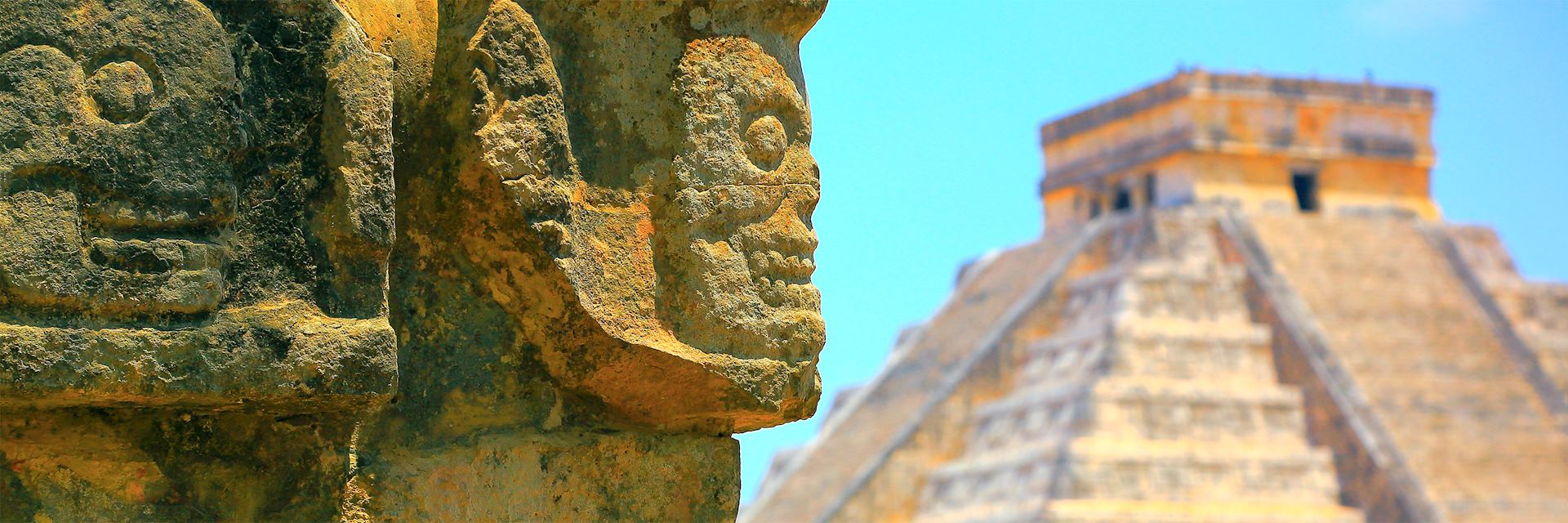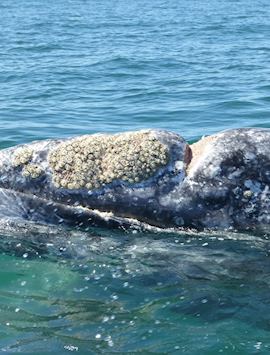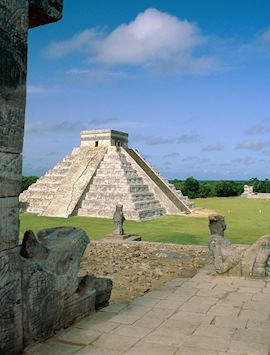By Mexico specialist Carolyn
Mexico first captured my attention when I studied the Aztec and Maya at school. Since then, I’ve explored many of the sites they left behind, but I’ve also learned that Mexico has many other faces.
You can ride a winding railway through canyon ridges. Look into the eye of an inquisitive grey whale. Sit down with local people to munch tortillas baked over an open fire. Pass through a lively market pulsing to the trumpeting of a mariachi band.
A good network of internal flights makes it easy to explore different areas of Mexico within the same trip. Alternatively, you can home in on one area. Baja California and the Yucatán, for example, are deceptively vast: you could spend a fortnight in both and still not see everything.
Things to do in Mexico: My selected highlights
Explore Mexico City and surrounds

Every hour is rush hour in Mexico’s densely populated capital. But once you reach the central historical district, the seven-lane traffic is left behind.
This is a more cultural, cosmopolitan city than it seems at first glance. A grid system of streets spans out from the city’s colonial-era main square, the Plaza de la Constituciόn, or Zócalo. It was built by the conquistadors over the original Aztec city of Tenochtitlan. Today, the Metropolitan Cathedral, the National Palace (the country’s governmental hub) and streets filled with museums encircle the Zócalo.
The ruins of an Aztec pyramid, the Templo Mayor, dominate part of the square. It’s a fitting introduction to Mexico’s layering of indigenous and Hispanic cultures.
Discover Mexico’s artistic heritage

Mexico’s art history is rich. In Mexico City, you can scratch the surface by exploring the legacy of painters Frida Kahlo and her husband, Diego Rivera.
I’d first head to the National Palace to see Rivera’s murals. They depict his country’s history from Cortez’ arrival in the New World to 20th-century Mexico.
After crossing a quiet inner courtyard, you’ll come to a grand staircase. Standing at the bottom of it, you’ll get your first glimpse of his floor-to-ceiling tableaus. They take up the palace’s entire first floor. In terms of detail and drama, they’re comparable to Michelangelo’s Sistine Chapel ceiling.
The suffering of Mexico’s indigenous peoples is vividly represented. Look out for the figures of Frida Kahlo — Rivera painted her into several scenes. I liked some of the more mundane background details, too. For example, goats roam around in some scenes, and Rivera portrays native Mexicans staring at them in bewilderment. This is accurate, as the animal was brought over by European settlers, and before then unknown to Mexico.
You can see many of Frida Kahlo’s paintings at the city’s Museum of Modern Art and the Dolores Olmedo Museum. Visiting her home, the Blue House, is a quirkier way to get an insight into her life and work.
The house and its objects have been preserved exactly as they were on the day of her death. Hairbrushes are still knotted with hair. Shawls are draped on beds. A painting stands unfinished on her easel. Her wheelchair sits empty. Heavily influenced by Amerindian cultures, Frida’s rooms are adorned with folk art. Her ashes sit in a Colombian urn on a dressing table.
Take a boat ride in the Floating Gardens of Xochimilco

After an hour’s train journey from the Zócalo, you enter a brightly decorated parallel universe. Xochimilco is the remains of an ancient canal system built by the Aztecs. It’s a series of waterways intersected by artificial islands where crops and flowers grow.
Try to visit on a Saturday — market day. You can take a private tour of the gardens on a traditional trajinera (gondola). These flat boats are painted in vibrant rainbow hues, with sheltered seating and their names emblazoned on a decorative archway.
You’ll then enter the throngs of watercraft, many carrying local families, to make your way through the floating market. While a mariachi band plays nearby and children shout, you’ll pass boats laden with locally farmed produce, handicrafts and textiles. Sample some street food, like corn on the cob, and enjoy the fiesta atmosphere.
Climb the pyramids of Teotihuacán

You feel like an ant in the ruins of this ancient Mesoamerican city, an hour’s drive from the capital.
Descend the steps into the Avenue of the Dead, flanked by sacred buildings and the former residences of the city’s elite. Ahead lies the gigantesque pyramid known as the Temple of the Sun. Behind you is the smaller Temple of the Moon. The original temples, wooden structures on top of the pyramids, are long gone. But you can climb a long flight of deep steps to the top of each structure.
The view makes the steep, long ascent worth it. In one direction, you look out over sparsely inhabited grassland, in the other, the cityscape of the capital. It’s a juxtaposition of rural and modern, urban Mexico.
Turn archaeologist at Maya sites

A two-hour flight from Mexico City to Mérida brings you to the heart of the Yucatán. This porous limestone peninsula, carpeted in jungle and riddled with cenotes (sinkholes), hides some beguiling Maya ruins.
Visit Chichén Itzá

Probably the epitome of Maya architecture, in its 12th-century heyday Chichén Itzá was a sacred and ceremonial place, and a trading hub. Get there early, around 8am, to see the site at its best. The souvenir stalls are still being set up, and the busloads of visitors have yet to arrive.
In a site full of wonders and intriguing accounts of Maya customs, the ball court really stayed with me. In this vast, stone-walled space (160 x 70 m, or 525 x 229 ft) open to the sky, Maya men played a game of life or death. It’s believed that the captain of the victorious team would be sacrificed to the gods. One of the court’s wall carvings depicts this act.
I was also struck by the Temple of the Warriors, a long platform of intricately carved columns. Some are intact, others crumbling. The theory goes that each pillar represents a warrior who died defending the citadel.
Other Maya sites in the Yucatán

Closer to Mérida, Uxmal is smaller than Chichén Itzá. At times, it seems to have been taken over by basking iguanas. What I remember most about Uxmal is the symmetrical designs incorporated into a lot of its structures, and how the most important buildings — like the main temple — were framed and accentuated by doorways as you approached them.
Tulum, on the Mayan Riviera, has explanatory plaques and can be explored independently if you stay in the small beach town nearby. Avoid going at midday — there’s no shade. Look out for the Temple of the Wind perched right on the edge of the cliffs, overlooking the cyan Caribbean Sea.
Eat chocolate in Oaxaca

This relaxed colonial city, Mexico’s culinary capital, lies a one and a half hour flight southeast of Mexico City.
I love visiting the markets here. If you have a sweet tooth, head for the chocolate makers’ stalls. Here, you’ll find women grinding cocoa beans on large stones. Many local people use the resulting raw paste to make mole, the unctuous chilli sauce Oaxaca is known for.
You can watch the making of handmade chocolates in artisan shops, where you can also sample the finished product. The taste is slightly bitter, compared with what you might expect, but delightfully rich and creamy.
After a morning of shopping, I like to seek refuge in the city’s botanical gardens. Tucked behind a church and a former monastery, they’re full of many species of native cacti and orchids. Once, when I was visiting, I accidentally found myself part of a wedding taking place at the church. The bride, on noticing me, nodded and smiled gently as she glided past.
Ride the Copper Canyon Railway

Northwest Mexico is the starting point for arguably one of the world’s greatest rail journeys. Terminus to terminus, it’s a 15-hour journey across Mexico’s northern wilderness to Chihuahua. Chihuahua as a destination doesn’t have much going for it, but in this case, it’s the journey that counts.
You board the al Pacifico train at El Fuerte in western Mexico. This small colonial town is reached by a two and a half hour flight from Mexico City, then an hour’s car ride.
The train — known as El Chepe — snakes its way through the interlocking canyons that make up Copper Canyon. Then it enters the Sierra Madre Mountains. This is the scenery of Hollywood Wild West movies, the place where revolutionary bandits hid out and skirmished.
The train passes through a landscape of pine forest, desert badlands, and waterfalls. You’ll cross precipitous bridges over sometimes surprisingly green gorges.
En route, you can arrange to stop for the night to break your journey. I would recommend staying overnight at Barrancas, a former Franciscan mission outpost perched on the edge of the Copper Canyon. (Try to stay in the Hotel Mirador for the best views overlooking the gigantic rippling ridges). Barrancas is home to communities of Tarahumara Indians and you’ll hear hardly any English spoken. Here you can also go horse riding, walk to viewpoints, or take a trip on a cable car.
Go whale watching
Swim with whale sharks and relax on Isla Holbox

If you’re looking for a retreat, this is the place. Forget the crowded, overdeveloped Mayan Riviera. This sleepy, car-free island off the coast of the Yucatán Peninsula is ideal for relaxing on white-sand beaches. One of its main draws is the chance to swim with whale sharks, the largest fish in the sea.
Sightings are highly likely between June and September. It's possible to get in the water and snorkel alongside the whale sharks, providing you keep a respectful distance. Despite their size and cavernous, filter-feeding mouth, these creatures pose no danger to humans. In fact, they’re known for their docility. Look out, too, for small fish hitchhiking on a whale shark’s back.
Get close to grey whales in Baja California

This limb of western Mexico is the second largest peninsula on Earth. It’s a barren stretch of desert, oasis towns, and barrel and cordon cacti (among many other species). But its real treasures lie off the coast, in the Gulf of California.
From mid-January to early April, grey whales come to calve in the warm waters of San Ignacio Lagoon, Magdalena Bay, and Scammon’s Lagoon. You can see these whales in close proximity on a whale watching trip. As your boat enters these waters, the whales will approach. Curious and friendly by nature, they’ll willingly surface and come within inches of you. Later in the season, they may be accompanied by playful youngsters. It’s truly as close as you’re ever likely to come to these graceful marine mammals.
Elsewhere in Baja California, you can see humpback whales breaching and spyhopping (holding their bodies vertical and popping their heads out of the water) in the Sea of Cortez. Meanwhile, sea lions, dolphins and blue-footed boobies cluster around Espiritu Santo Island, a short boat trip from La Paz.
Lesser-known highlights in Mexico
Admire the views from Monte Albán

If you have time while in Oaxaca, I suggest making a trip to see these windswept Zapotecan hilltop ruins. The Zapotecs were an indigenous pre-Columbian people who flourished in the Oaxaca highlands area.
You’ll need a bit of imagination to appreciate Monte Albán fully. But, when you look out over the valley, it’s easy to understand how this was once a pre-Hispanic powerhouse. It’s also — thanks to fewer visitors — one of the most peaceful, atmospheric sites in Mexico. The low-lying structures and earthworks, however, haven’t weathered as well as in other sites.
Visit a women’s cooperative in Chiapas

San Cristóbal de las Casas is a quaint town of cobbled streets with a European feel. It’s also the gateway to some highly traditional surrounding villages. Many of their inhabitants have retained their pre-Hispanic traditions, and speak a local dialect. You’d get there by taking a one-hour flight from Mexico City to Tuxtla Gutiérrez, then an hour’s car transfer.
In the village of San Juan Chamula, a group of local women have turned against their community’s customs. They’ve chosen not to marry. Instead, they live and work together in a cooperative, making and selling garments and handicrafts. When I visited, the women dressed me in their patterned, handmade shawls and wraps. The fabric was heavy but, as they explained, this actually helps protect them from the heat.
I also learned how to make tortillas with various fillings over a firepit. One of the women showed me how to grind pumpkin seeds into a greyish paste. It looked unappealing, until she added salsa and lime juice. This transformed the mixture into a vivid orange. Smeared into the freshly baked tortillas, it tasted delicious.
Start planning your trip to Mexico
Start thinking about your experience. These itineraries are simply suggestions for how you could enjoy some of the same experiences as our specialists. They’re just for inspiration, because your trip will be created around your particular tastes.
View All Tours in Mexico




